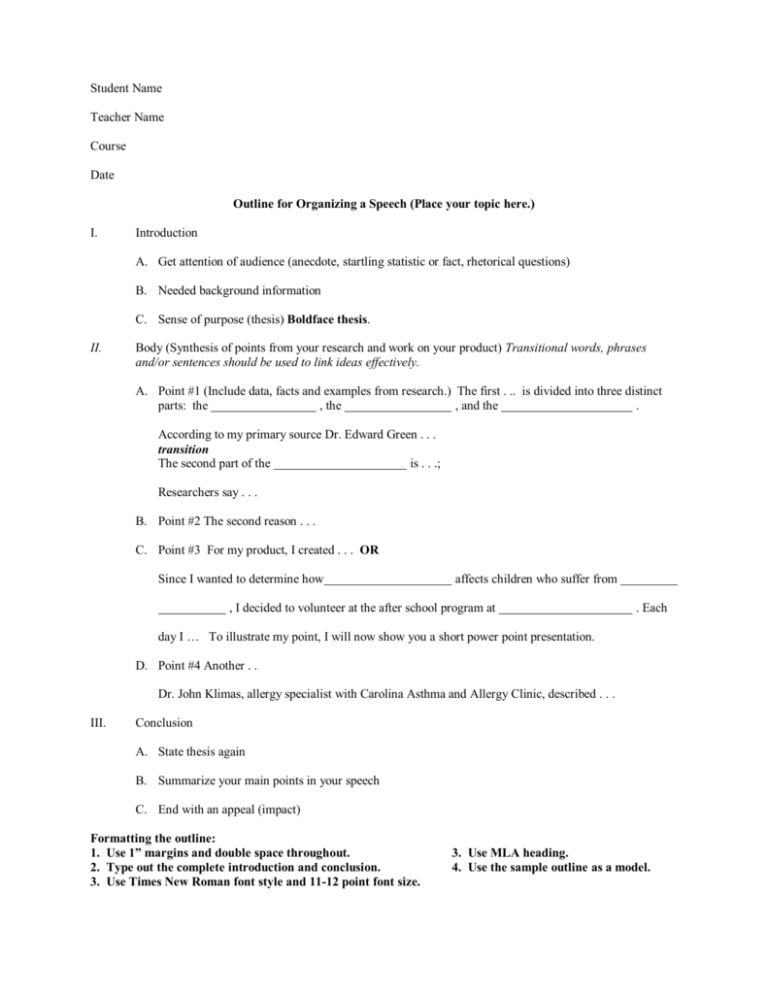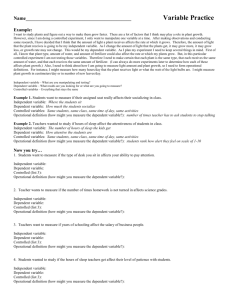Outline for Organizing a Speech
advertisement

Student Name Teacher Name Course Date Outline for Organizing a Speech (Place your topic here.) I. Introduction A. Get attention of audience (anecdote, startling statistic or fact, rhetorical questions) B. Needed background information C. Sense of purpose (thesis) Boldface thesis. II. Body (Synthesis of points from your research and work on your product) Transitional words, phrases and/or sentences should be used to link ideas effectively. A. Point #1 (Include data, facts and examples from research.) The first . .. is divided into three distinct parts: the , the , and the . According to my primary source Dr. Edward Green . . . transition The second part of the is . . .; Researchers say . . . B. Point #2 The second reason . . . C. Point #3 For my product, I created . . . OR Since I wanted to determine how affects children who suffer from , I decided to volunteer at the after school program at . Each day I … To illustrate my point, I will now show you a short power point presentation. D. Point #4 Another . . Dr. John Klimas, allergy specialist with Carolina Asthma and Allergy Clinic, described . . . III. Conclusion A. State thesis again B. Summarize your main points in your speech C. End with an appeal (impact) Formatting the outline: 1. Use 1” margins and double space throughout. 2. Type out the complete introduction and conclusion. 3. Use Times New Roman font style and 11-12 point font size. 3. Use MLA heading. 4. Use the sample outline as a model. Andrey Voronin Mrs. M. McDuffie English 12 16 November 2010 Sleeping Disorders I. Introduction A. Attention Getter: On Friday February 21st at around noon after their midterm, four best friends decided to spend their weekend in their home town with family and friends. They decided to leave a little early because the drive was about two hours, and they still wanted to visit their high school teachers. One of the boys, Pete, drove his nice car, a gift from his grandparents. After driving about half way, Pete fell asleep and ran a red light; his car smashed into a pickup truck at 62 mph. Dan stated, ―I found myself in the car alone; I did not know what happened. The first thing that I realized was that Bob who had been sitting next to me had left his shoes in the car, and before I had time to think any more I realized the situation.‖ Right now Bob is the only one alive and well. Pete is a living vegetable; he does not react to his surroundings—just emits faint breathing and a light heartbeat. The other two died at the scene. Pete’s friends did not know he had Restless Leg Syndrome (RLS), and he did not tell them, probably because he was embarrassed by it. B. Background: During our lifetime all of us will experience a temporary lack of sleep, but a chronic lack of sleep can lead to devastating consequences. Not only can sleep deprivation lead to serious conditions such as heart disease, depression, or heart disease; but it can also prove to be fatal as in the case with Pete and his friends. Sleep disorders are a highly common medical issue that affects millions of Americans each year. Without adequate rest, the brain's ability to function quickly deteriorates. C. Thesis: Sleep is a precious gift that allows people to rest. Not getting enough rest on a constant basis can lead to greater problems, even death. II. Body (Synthesis of points from your research and work on your product) Causes of sleep deprivation vary including stressful lifestyles and many sleeping disorders. A. Insomnia , the most common sleep disorder 1. Description 2. Symptom of other disorder 3. No age discrimination 4. Effects Results of a study released by the Nebraska Rural Health and Safety Coalition show, “the brain works harder to counteract sleep deprivation effects, but operates less effectively: concentration levels drop and memory becomes impaired.” B. Sleep Apnea 1. Definition 2. Causes a. Obstruction of airway b. Failure of respiratory system 3. Effects – no deep stage of sleep -- National Highway Traffic Safety Administration (NHTSA) C. Restless Leg Syndrome (RLS) -- The Stanford University Sleep Research Center 1. Description 2. Affected of body area – calf of leg 3. Signs 4. Effects -- 100,000 automobile crashes, 71,000 injuries, and 1,550 fatalities-NHTSA F. Product – Sleep Journal (You may show your visual/technology at any stage.) 1. Description 2. Duration 3. Experience 4. Findings/ Results III. Conclusion A. Restatement of Thesis: Sleep is a very precious gift that allows people to rest. Not getting enough rest on a constant basis can lead to greater problems, even death. B. Summary: Insomnia, sleep apnea, RLS (Restless Leg Syndrome), and narcolepsy are just among the most common disorders that seriously affect our health in the form of physical and mental impairments. Inadequate rest impairs our ability to think, handle stress, maintain a healthy immune system, and moderate our emotions. In fact, sleep is so important to our overall health that total sleep deprivation has been proven to be fatal. C. Impact: To avoid the mistake Pete made by driving and, most of all, not telling his friends about his disorder, I encourage everyone not to conceal serious disorders from family and friends and to make wise choices.





